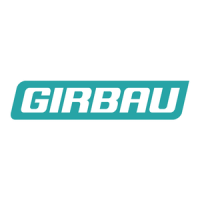
Do you have a question about the GIRBAU HS-4007 and is the answer not in the manual?
Warns about electrical shock hazards and protection guards for components.
Highlights risks associated with moving parts and protective guards.
Advises caution for surfaces susceptible to quick temperature rises.
Details precautions regarding inhalation of harmful vapors.
Alerts about potential risks for the user, machine, or fabric.
Highlights notes requiring attention or important information.
Provides the definition and purpose of the Girbau washer-extractors.
Details the construction specifications for LS and HS models.
Explains crucial safety devices and warnings for machine operation.
Instructions for safe door operation, including locking and opening.
Procedures and safety precautions for the initial startup of the machine.
Describes different modes for stopping the machine programmatically or normally.
Explains how the machine behaves and recovers from sudden power failures.
Lists prohibited actions and materials for safe and correct machine usage.
Recommends personal protective equipment for safe operation.
Details the microprocessor's capabilities, functions, and programming.
Provides an overview of the control panel layout and its components.
Explains the function of various control devices like switches and LEDs.
Lists and explains various messages and codes displayed by the machine.
Covers machine configuration options for installation and application needs.
Details the procedure for resetting machine settings to factory defaults.
Explains how to view machine model, EPROM version, and heating type.
Guides on configuring various operational parameters for optimal machine use.
Explains the function of each numeric key in MANUAL mode.
Provides instructions for accessing and using MANUAL mode operations.
Details available wash programmes with settings for different fabric types.
Guides on executing wash programmes, loading, and using the dispenser.
Explains how to check program status, phase, and temperature during execution.
Details how to make minor adjustments to programs during execution.
Information on accessing and viewing programme contents and execution reports.
Overview of pre-recorded and user-programmable wash cycles.
Step-by-step guide to programming custom wash cycles.
Instructions for installing and programming optional machine functions.
Procedure for copying existing programmes to other memory locations.
Guide for modifying user-programmed cycles or copied programs.
Instructions on how to erase programmed or copied cycle data.
Details error codes displayed by the machine and their probable causes.
Identifies mechanical risks and corresponding prevention actions.
Details electrical risks and necessary prevention measures.
Covers risks related to high temperatures and burns.
Addresses risks associated with noise levels and prevention.
Explains risks from vibration and preventive measures.
Covers risks from wash products, steam exhaust, and contamination.
Addresses risks related to posture, PPE, lighting, and human error.
Details risks from power supply failure and machine part breakdown.
Covers risks from missing or incorrectly positioned safety devices.
User-performed preventive maintenance schedule and tasks.
Troubleshooting guide for common alarms, causes, and solutions.
Detailed procedures for user maintenance and corrective actions.
Procedure for safely removing the washer from service.
Lists recyclable or recoverable materials used in machine construction.
Step-by-step guide for configuring machine settings (CONF 1).
Guide for configuring machine operation settings (CONF 2).
Instructions for accessing and performing custom programme programming.
Details on accessing and using additional machine functions and options.
